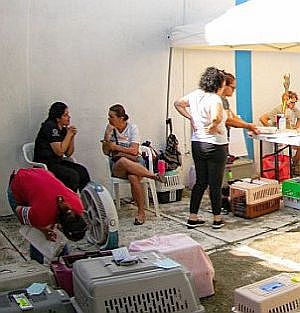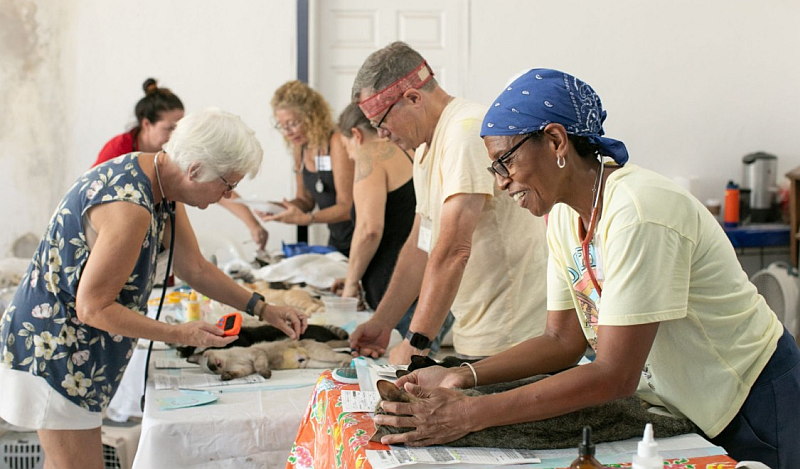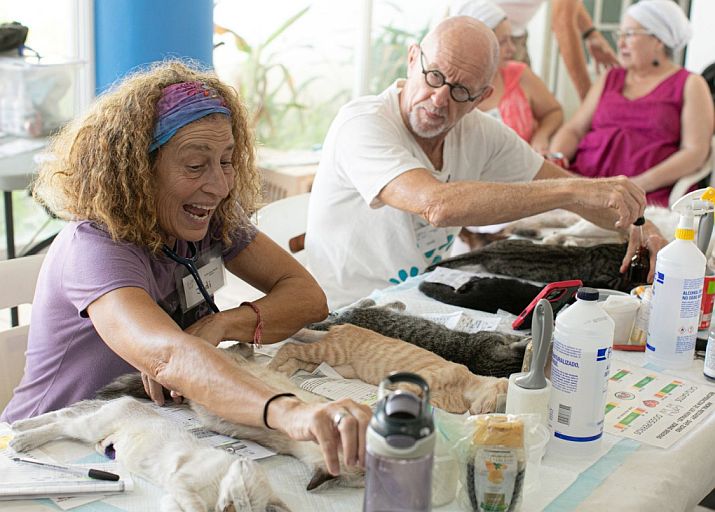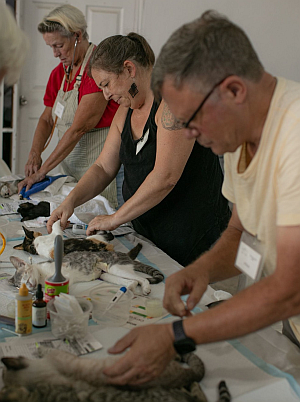
Puerto Vallarta, Jalisco, Mexico – It was already a warm Puerto Vallarta summer morning, and the smells of disinfectant hung in the air. Fans hummed in the corners of an open courtyard. Metal tables gleamed under fluorescent lights. And a row of kennels lined walls, already occupied by a chorus of early arrivals, including dogs, cats, and one very nervous Chihuahua.
This is Part Two of my Cuale Spay and Neuter Clinic in Puerto Vallarta series. In my last article, I looked at the organization itself, the free surgeries, the impact on the stray animal population, and the community outreach. But today’s focus is the people behind it all. The volunteers. The ones who prep surgical tables, comfort groggy cats and dogs, translate for worried owners, and clean up everything at the end of the day.
They come to each clinic because they believe in what happens inside the walls.
Recently, I spent the morning following them. Watching, listening, and asking questions as they moved through the hours.

Andrea Guerrero Conado was working intake, sitting beside nervous, skittish animals, gently petting their heads, and whispering to them in both English and Spanish. It was beautiful watching her calming presence amid the activity around her.
She’d adopted her own pup, Jean, seven years ago. Four months into pet ownership, a stray dog followed her and her pup on a walk.
“We’d had dogs follow us on our walks before, but usually they go away after some time. This one stayed, following us everywhere. It turns out she’d been left by her previous owners, who moved apartments without taking her with them.”
Andrea could tell this pup was different from the more aggressive strays she’d seen, and she wanted to help. But the costs of owning a new dog would have been crippling.
“A Dog’s New Life helped me with food and vet bills for a few months, as they’d looked for a more permanent placement. I named her Dina, and she came to stay with us. One part of the fostering responsibility was to get Dina fixed, and they directed me to this clinic. When we went for the appointment, I saw people struggling with the language, since most people who come to the clinic are Mexican, so I offered to step in and translate.”
Thus, a volunteer career was born.
“I’ve been doing this since 2019, and it’s the most fulfilling thing. It’s important, so being a part of making sure people are doing things responsibly for their animals is a wonderful feeling.”
“What keeps me coming back?” she repeats when I ask. “That’s easy. You see fewer puppies in the street. Fewer litters getting dumped in boxes. You start to realize you’re not just helping animals; you’re changing the whole community for the better.”
The clinic quickly went into full swing. Animals were on the surgical rotation, one after another. Volunteers moved like gears in a well-oiled machine, prepping animals, handing tools to the vet, monitoring vitals, logging information.

I spoke with Shashanda Trujillo, a volunteer for three years. She not only works recovery but also trains new volunteers. I was mesmerized by how much she smiled. Even though the day was fast-paced and hectic, Shashanda’s demeanor gave pet owners a type of comfort they didn’t even know they needed. It’s remarkable what a smile can do.
“I was volunteering at the Municipal Animal Shelter when another volunteer shared information with me about the clinics. Once kittens and puppies are born, they need care, of course, but I see spaying and neutering as the solution to the root problem of overpopulation. I jumped at the chance to be part of this group!”
But the work itself isn’t without sadness at times, as there are issues that stray animals face that aren’t always fixable. But that’s when compassion is at its most critical.
“Last year, I participated in a remote clinic north of Puerto Vallarta. There was a man who brought several street dogs who were in his care. As it turned out, one of the females had an incurable and highly contagious venereal disease. Out of concern for other street dogs, he made the difficult decision to put her to sleep. I stayed with them until she was gone. It was a very emotional and humbling experience.”
The clinic does far more than offer free spay and neuter services. They provide pet owners with information vital to giving their animals a better start in life. They provide information and resources that clearly outline the importance of responsible pet ownership, and the message spreads deep into outlying communities.
“The clinic also works closely with animalistas, those who trap, sterilize, and release feral cats. This helps significantly in reducing overpopulation in the community.”
What would she say to someone considering volunteering or supporting a clinic like this?
“Whether one has time, money, or both, they should consider supporting the clinic. It’s a very rewarding way to give back to the community, and it gives me great satisfaction knowing that I help give better outcomes to cats and dogs alike.”

I met Jodi Wolk. Her ability to remain calm under pressure and to show such an eagerness to help is something that’s stayed with me. If she could bottle it up, I’d be first in line for the sale.
“I was inspired to start volunteering at the clinic because in my neighborhood, many cats and dogs are living on the streets. I felt that participating in the sterilization process would help reduce the number of animals roaming the streets without homes. Because the clinic is free, people are motivated to bring their animals in to be sterilized. This opportunity deters owners from having to make difficult decisions due to a lack of money needed to support them.”
But the work isn’t without its challenges.
“Sometimes there are three to four cats and kittens in front of a volunteer, and it can be a bit stressful to take their vitals in a consistent way. And then a dog arrives!”
I asked Jodi a final question. Through all of it, the good, the bad, and even the ugly, what would you say to someone considering volunteering?
“Volunteering in a clinic like this gives someone an opportunity to help a cat, a kitty, a dog, or a puppy with a better quality of life, and it helps to reduce the number of homeless animals struggling to survive in the streets.
A beautiful reason, indeed.
By late morning, the rhythm begins to slow. Fewer animals are coming in now, and the team is focused on recovery and making sure everyone is stable before heading home. There’s a small pup in Andrea’s lap, swaddled like a baby.
As people are sweeping and packing up supplies, I sit down next to a gentleman who’s brought in some sort of shepherd mix. In my broken Spanish, I ask if I can pet his dog. He smiles with such pride, and he tells me, “por supuesto.”

I ask what he thinks about everything going on around him, about the people helping him by making it easier to do the right thing for his pup.
“Mucho gratitud. Siempre gratitud.”
The volunteers move quietly now, as the energy is different. It’s slower and more tired. But the smiles haven’t faded. It’s something I firmly believe is down to Shashanda rubbing off on everyone.
I ask one last question to whoever’s left in earshot. Is there anything else you’d want people to know? There’s a chorus of answers:
“We’re always looking for more help.”
“Even small donations go a long way.”
“Just showing up makes a difference.”
Whether you’re visiting Puerto Vallarta or calling it home year-round, the Cuale Spay and Neuter Clinic is always seeking new volunteers and supporters. No medical experience is required, just love, patience, compassion, and a willingness to get a little dirty and hands-on.
Amid the heat and the hum of fans, you’ll find wagging tails and grateful hearts, a small but powerful reminder of the lives being transformed. One surgery, one volunteer, and one life at a time, it’s all making a lasting difference.
If you’d like more information or you’d like to donate as a means of ensuring the Cuale Spay and Neuter Clinic’s continuation, I invite you to visit their partner website, Paws and Claws PV.





